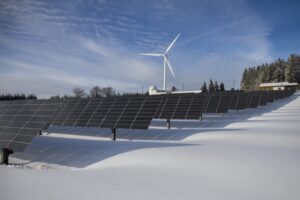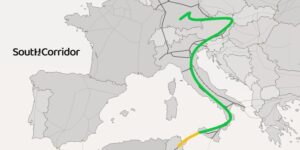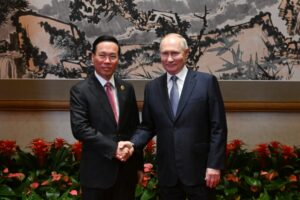On 16 March 2022, the European Commission declared the synchronisation of the frequency of energy systems in Ukraine and Moldova to ENTSO-E, the European integrated energy network.
The European Union is with the project of greater autonomy and internal independence, mainly in the energy field, in which it depends on imports of Russian fossil fuels.
Including Moldova and Ukraine is a way to further address the EU’s domestic energy needs, as well as reducing the number of countries that have an essential dependency on Russia. It is a means of strengthening itself as a geopolitical actor and diminishing Russian power in other nations.

What is the European Union’s Energy Union Strategy
The European Union has for some years been searching for greater strategic autonomy, including in the energy field.
Since 2005, the EU has developed a first Energy Policy (European Union Energy Policy) programme to minimise its dependence on fuel and energy imports.
In 2007 the Union imported 82% of its oil and 57% of its natural gas, being the world leader in energy imports. Russia, Canada and Australia are the EU’s main suppliers. Even with new policies, in 2015 they still imported 53% of the energy they consumed.
It was from 2015 that the European Commission created the “Energy Union“, a plan to increase the energy independence of all Member States of the European Union. With the goal of interconnecting electric power generation and consumption systems between countries, they sought 10% interconnection by 2020 to create an internal energy market.
The objective of this European internal market is to lower energy prices, reduce the need to build new power plants, reduce the instability of the electricity grid, improve the reliability of renewable energy supply and encourage market integration.
The whole plan follows 5 main priority guidelines:
- Energy security, solidarity and trust
- A fully integrated European energy market
- Energy efficiency contributing to moderation of demand
- Decarbonising the economy
- Research, innovation and competitiveness.
What is the Synchronisation of Ukraine and Moldova to the Continental European Grid?
On 16 March 2022 the European Union and ENTSO-E (European Network of Electricity Transmission Network Managers) announced in declaration the synchronization of Moldova and Ukraine na European Electric Network.
ENTSO-E is the main electric system in Continental Europe, with 39 electric transmission systems in 35 countries, and now in Ukraine and Moldova.
Kadri Simson, head of the EU Energy Commission, tweeted: “The electricity networks of Ukraine and Moldova have been successfully synchronised with the European Continental Grid. It’ll help keep the electrical system stable and your lights on. It is a historic milestone for our relationship – in this area, Ukraine is now part of Europe! “
With this inclusion there will be a savings of €200 million from Moldova in the creation and renovation of electric power stations. In addition, there is a propensity for growth of Ukraine’s economic exchanges with the European Union, mainly due to the production of Ukrainian nuclear energy which is the second largest in Europe after France.
There were already plans to include more countries in the EU’s energy integration policy by 2023, but the process was anticipated with the tensions of theRussia’s war against Ukraine.
How did Ukraine and Moldova’s electrical systems operate before the European synchronization?
As both are former Soviet countries, they participated in the electricity network currently run by Russia. This creates a situation of instability and insecurity, since in situations such as the current war, Russia has a certain control over the transmissionenergy of countries in which it has geopolitical interest of influence.
Since the first day of the war (24 February 2022) Moldova and Ukraine have cut the energy connection with Russia and Belarus.
Integration with the European Union greatly diminishes the vulnerability of dependency with the Russian government, as well as being a demonstration of the EU’s greater relationship with Ukraine and Moldova.
Moldova has been facing an energy crisis since the end of 2021 with threats of debt cuts in Russian natural gas, closing a financing agreement of EUR 60 million with the EU on 15 December, plus EUR 15 million to support the country’s recovery and to help build the Moldovan government’s capacity for energy reform.
The amount of Russian oil and gas entering Europe has increased since the beginning of the war in Ukraine. The European Union sent Russia around EUR 22 billion just to buy oil and gas in March 2022. But this could change in the coming months as countries implement plans to diversify their energy sources and reduce the flow of Russian oil and gas, with European energy integration being one such measure.
What is the future tendency to make the European Energy Union stronger?
A maior European Union autonomy is being achieved from an investment in the greater liaison and cooperation of States-members and allied European countries as a way to facilitate cheaper negotiations and strengthen the internal energy market.
The Baltic countries, which have been part of the EU since 2014, have not yet been synchronised to ENTSO-E, even depending on Russia’s energy network. But with the addition of Moldova and Ukraine to the system, its addition should not take long.
Being a Union of 27 countries, the EU has the possibility of self-sufficiency in strengthening its internal economic relations, especially in the production, transmission and commercialization of energy.
The need to reduce dependency on other countries (even more countries that are “adversaries” to their interests) is fundamental to the resilience of a nation (or intra-governmental union) in geopolitical conflict contexts.
At the same time, this energy autonomy of the EU weakens strategic opponents such as Russia, who lose influence in border countries such as Ukraine and Moldova, further weakening Russian power in the European continent.
























Be First to Comment